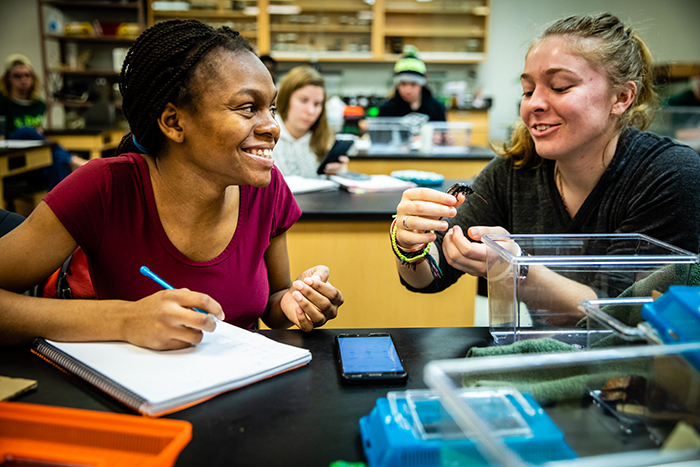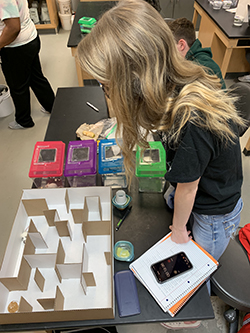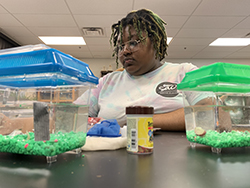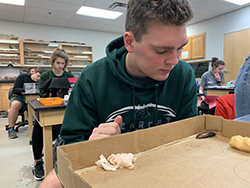
Students in a zoology lab spent Thursday conducting experiments they designed to observe the behaviors of fish, cockroaches, crickets and mice. (Northwest Missouri State University photos)
March 15, 2019
 |
Lacey Lancaster watches a mouse navigate a cardboard maze to find a container of peanut butter. |
 |
Jamiayla Phipps tested whether guppies preferred fish food or fresh food. |
 |
Andrew Blum watches a cockroach react to a selection of foods. |
With a timer on her smartphone, Lacey Lancaster watched intently Thursday as a white mouse sniffed the walls of a cardboard maze she constructed.
As part of a Northwest Missouri State University zoology lab, Lancaster, a sophomore biology education major from Sedalia, Missouri, was timing the mouse on how fast it navigated the maze to find a small container of peanut butter. She ran the test three more times, each with a different mouse, once more with peanut butter and two times with cheese.
“I’m testing to see which substance is better for catching mice within your home,” Lancaster said. “So cheese, which is typically a mouse’s favorite food, versus peanut butter because peanut butter is typically more fragrant so it can attract mice better. I’m going to time it and see which one can complete the maze faster and compare my data.”
Lancaster’s was just one of a myriad of tests students ran throughout the day with a variety of species to observe and collect data about animal behaviors during four iterations of the zoology lab.
Students were supplied with some basic equipment and access to a variety of animals, including cockroaches, mice, goldfish and betta fish. They wrote proposals for experiments to quantify and test predictions in animal behavior. Then, after receiving input from their instructors, they implemented and conducted their experiments.
The experiments not only gave biology students practical experience in handling and observing the various animals. It also helped the students gain a better understanding of the methodology and application that goes into such experiments.
“It’s more about them setting up and doing it then getting data that’s worth using,” Dr. Rob Arndt, an assistant professor of biology, said. “It gives them a better understanding of science, if they read science in the general public, and they understand how it’s set up. Science literacy is kind of a big deal right now and it’s important for them to understand how science is done, so when they actually do read about it, it has a deeper meaning.”
Most students conducted their experiments with betta fish. Some inserted mirrors into the water or covered the sides of their containers with dark paper. Others added varied lighting to their containers or changed the water temperature to see how the fish might react.
Jamiayla Phipps, a junior biomedical science and pre-vet major from St. Louis, Missouri, tested guppies’ interest in fish food versus fresh food by placing a grape in one of her containers. The fish avoided it.
“I think it’s awesome,” she said of the project. “It’s handling different types of animals. I have some experience handling more small animals like cats, dogs, rodents, so handling fish is a different experience for me.”
At a table next to her, Andrew Blum, a freshman biology major from Glenwood, Iowa, was tracking a cockroach’s attraction to a pear, slices of turkey and cheese. The cockroach, however, appeared more interested in trying to escape the cardboard lid that was containing him.
“I read an experiment about the pheromones the antenna picks up, so I was seeing if different organic foods were most attractive to the cockroach, something like a household food,” he said. “We had a lot of different options to choose from so it was whatever attracts your mind the most or whatever you want to learn more about.”
Back at Lancaster’s experiment, after her first mouse found the container of peanut butter in two minutes and 44 seconds, a second found it in just 19 seconds. A third mouse found the cheese in one minute and 25 seconds, and the fourth found it in one minute and seven seconds.
In addition to some knowledge about the behaviors of mice, Lancaster, who hopes to become a biology teacher, has some experience with an animal behavior experiment she can lead with a future science class.
“It’s super cool because I never really got to do anything like this in high school,” she said. “I think it’s something that I could implement in a future classroom.”